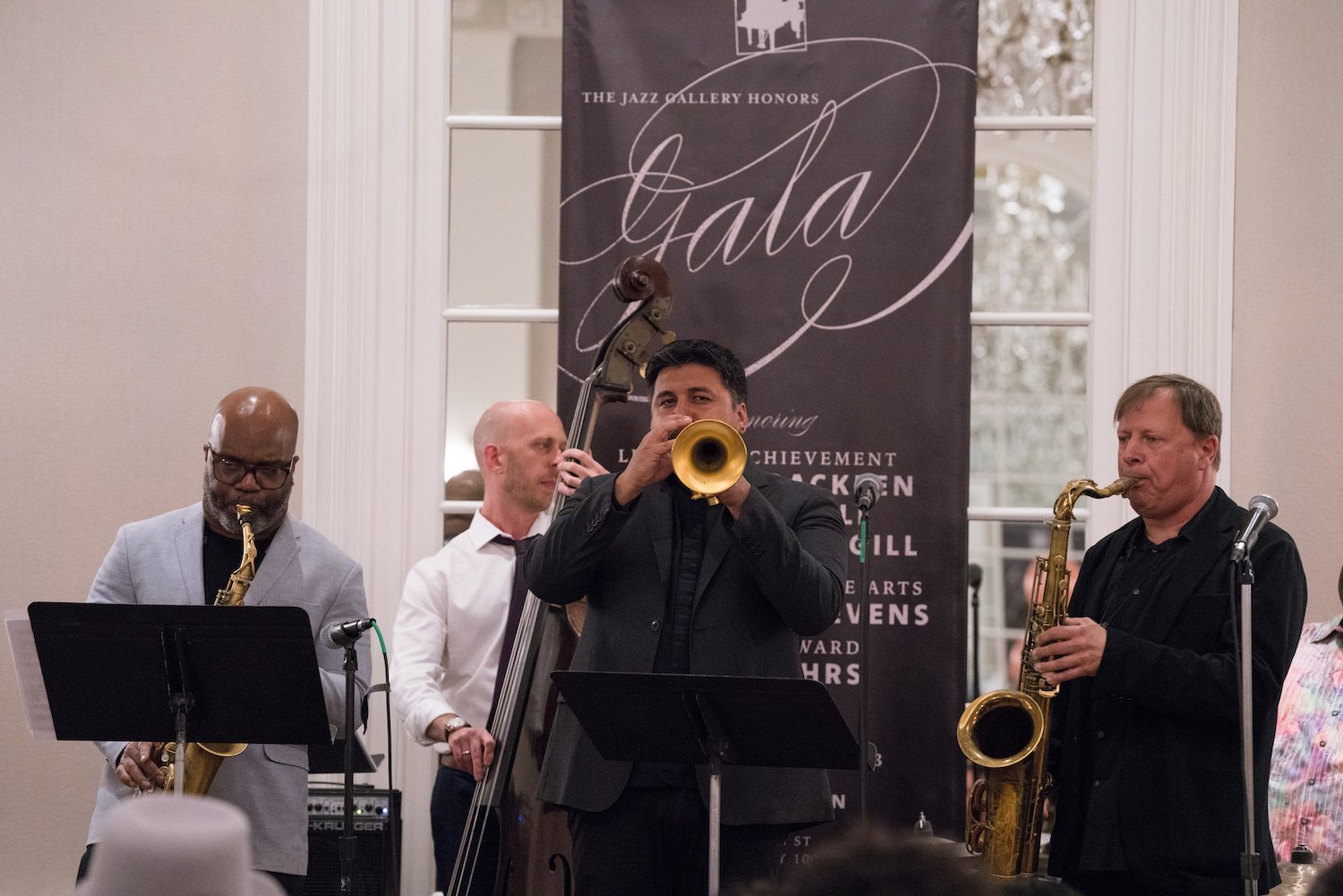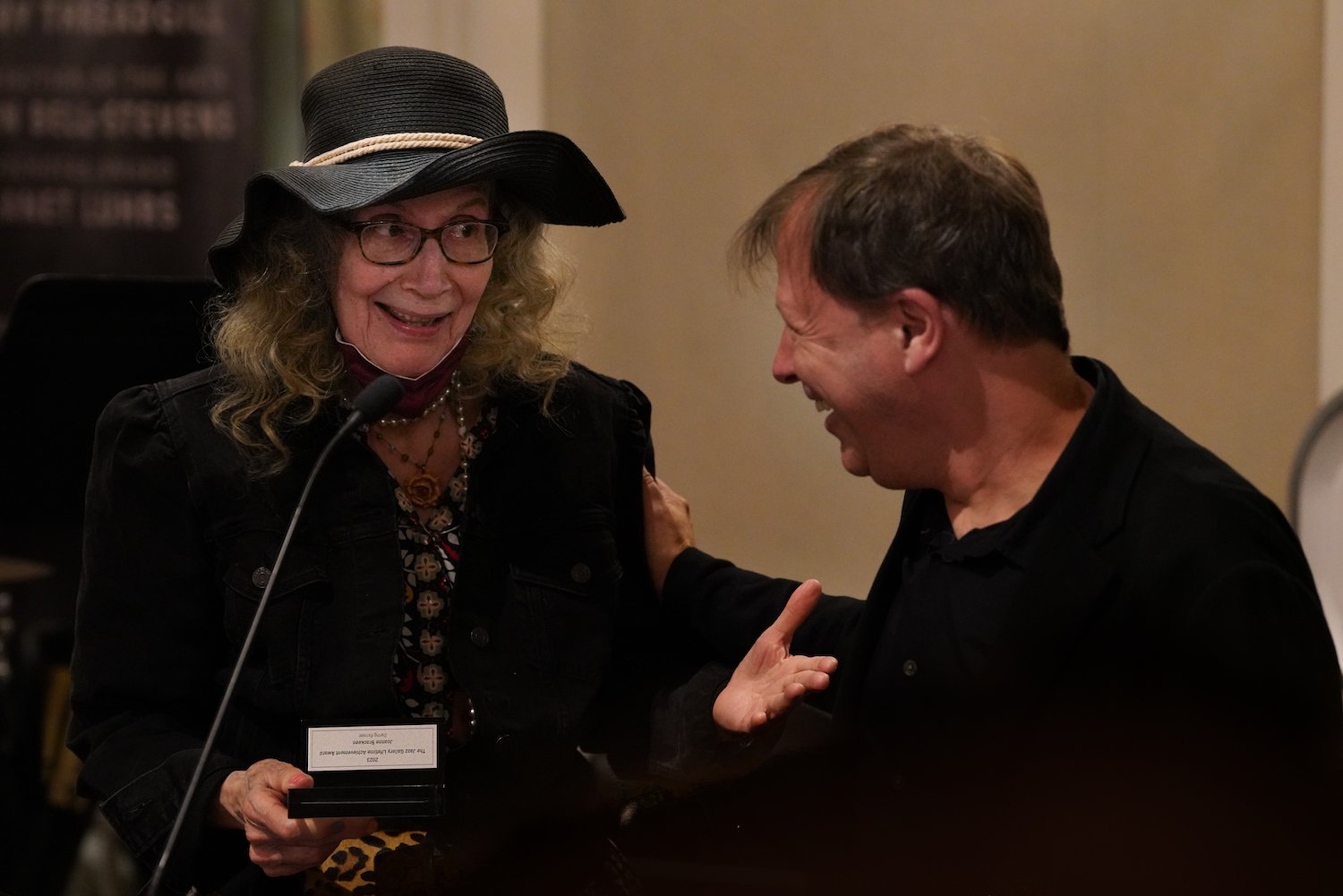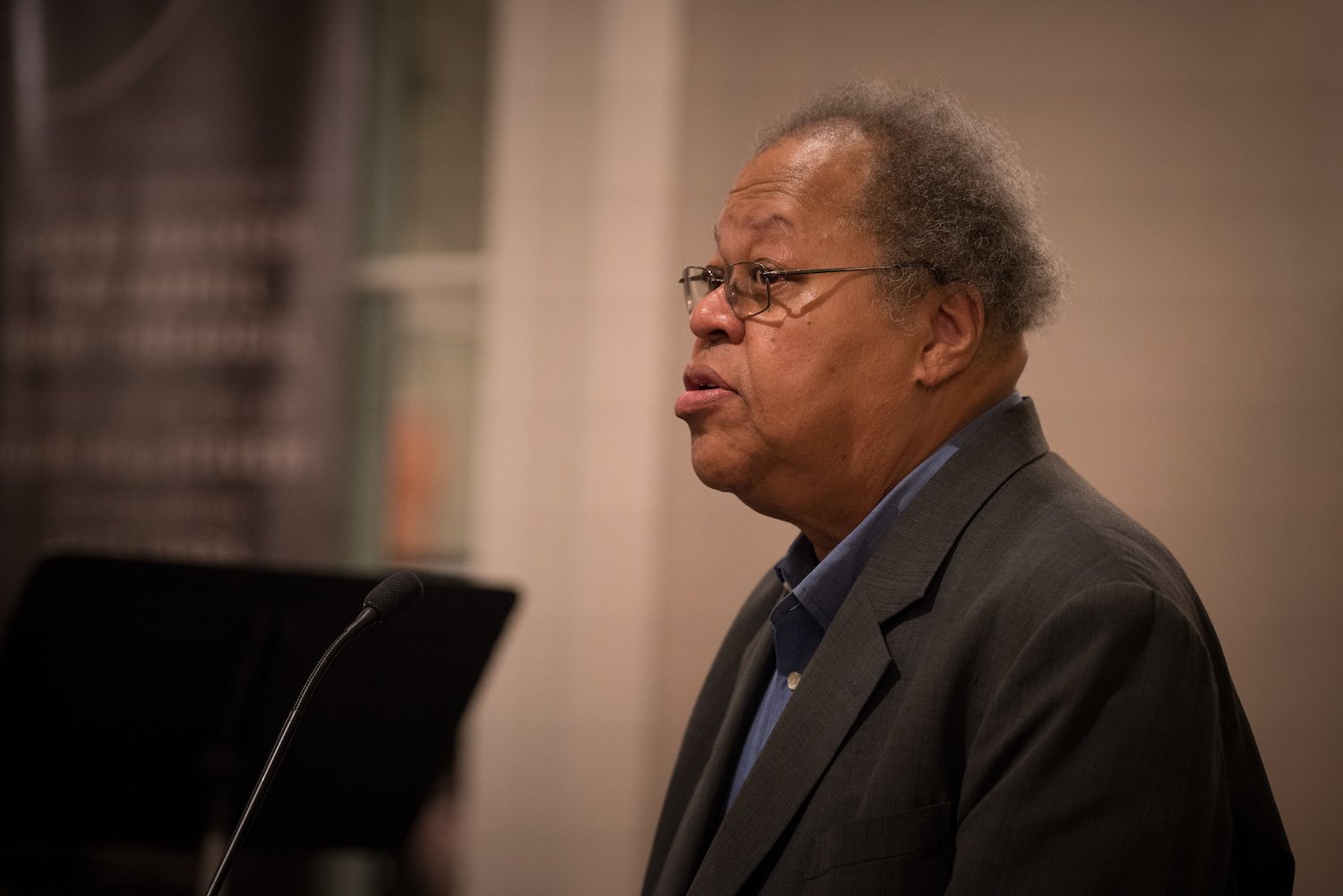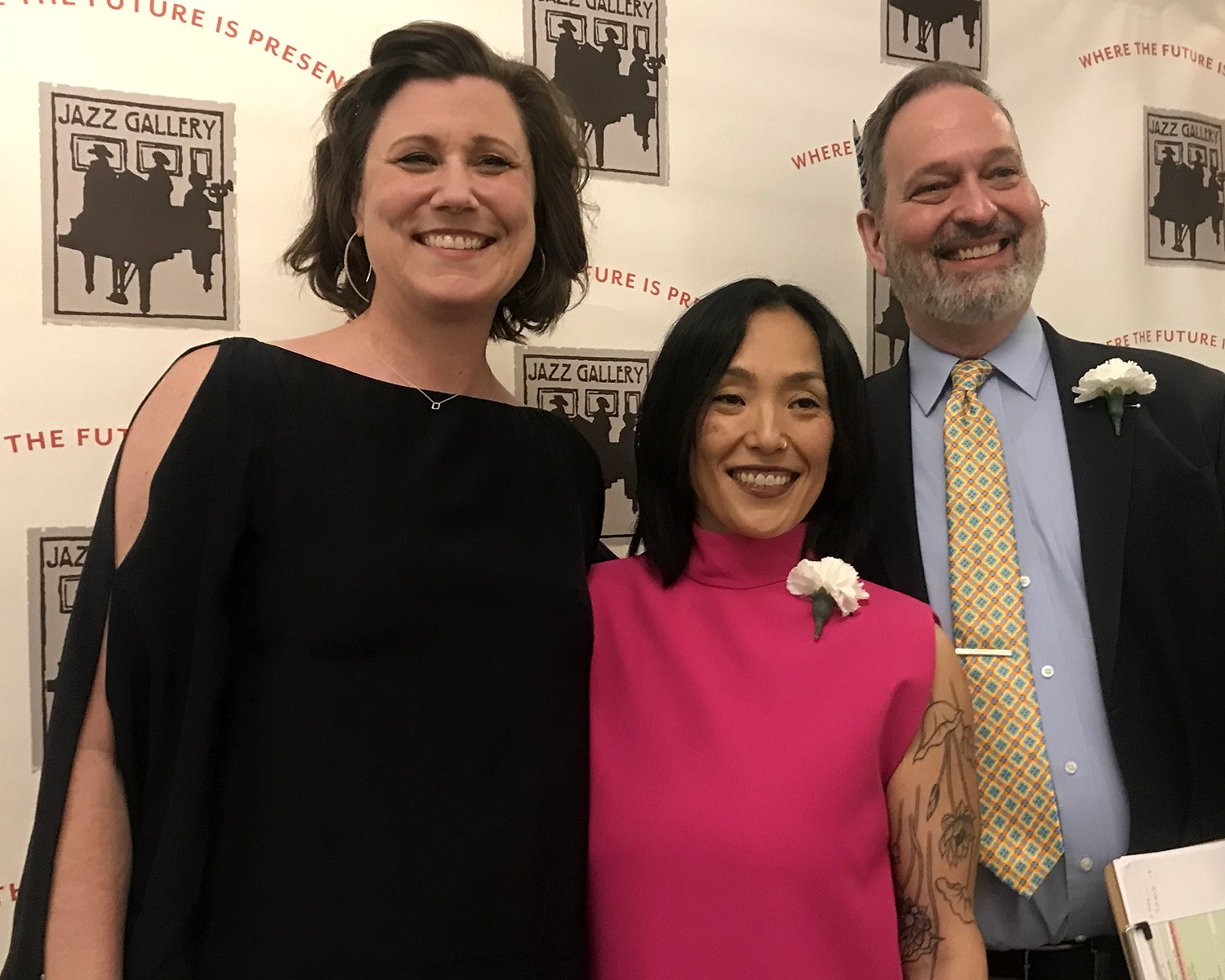THE JAZZ GALLERY HONORS GALA 2023
The Jazz Gallery celebrated five luminaries of the jazz world with music and festivities
at The Jazz Gallery Honors Gala on May 15, 2023!
Honoring
Joanne Brackeen
Tom Harrell
Henry Threadgill
Robin Bell-Stevens
Janet Luhrs
with presentations by
Joe Lovano
George Lewis
Chris Potter
Terri Lyne Carrington
and musical tributes by
Rowan Ricardo Phillips -poet
Arta Jekabsone -vocals
Jaleel Shaw -saxophone
Michael Rodriguez -trumpet
Kris Davis -piano
Matt Brewer -bass
Johnathan Blake -drums
The Jazz Gallery, founded in 1995 by Roy Hargrove, Dale Fitzgerald and Lezlie Harrison, is America’s premier performance venue for emerging international artists who challenge convention, take creative risks and lead their field as performers, composers and thinkers. Through residencies, workshops, and exhibitions, we provide a platform for artists to discover their unique voice and a home for established musicians to continue to experiment and grow. The Jazz Gallery has earned the reputation as “the most imaginatively booked jazz club in New York” according to the NY Times and is the three-time recipient of the prestigious CMA/ASCAP Award for Adventurous Programming.
Our Honors Gala, held annually each spring highlights and honors the work of those who have dedicated their lives to the world of jazz and to the stewardship of the art form. It is our largest fundraising event of the year, bringing together the honorees with a host of celebrated musicians performing in tribute, The Jazz Gallery Staff and Board of Directors, and a driven community of patrons and supporters. All in support of our mission!
The Jazz Gallery -Where The Future Is Present!
JOANNE BRACKEEN
Lifetime Achievement Award
NEA Jazz Master, Pianist
Whatever the musical setting—whether solo, duo, trio, quartet, or quintet—pianist Joanne Brackeen's unique style of playing commands attention. In addition to her captivating and complex improvisations, she has written intricate, rhythmically daring compositions in a wide stylistic range. She is a full-time professor at Berklee College of Music in Boston, Massachusetts, and a Berklee guest professor at the New School in New York City.
Brackeen was a child prodigy who at age 11, learned to play the piano in six months by transcribing eight Frankie Carle solos. By 12, she was already performing professionally. Some of her musical constituents at the time were Art Farmer, Dexter Gordon, Charlie Haden, Billy Higgins, Bobby Hutcherson, Scott Lafaro, and Charles Lloyd. Simultaneously, the Los Angeles Conservatory heard of her musicianship and offered her a full scholarship. She attended classes less than one week before deciding the bandstand was more significant.
Brackeen married and moved her family, including four children, to New York in 1965. She began her career there with such luminaries as George Benson, Paul Chambers, Lee Konitz, Sonny Stitt, and Woody Shaw among others. She joined Art Blakey's Jazz Messengers in 1969, becoming the first and only female member of the group, staying until 1972. Brackeen then performed extensively with Joe Henderson (1972-75) and Stan Getz (1975-77). After leaving Stan Getz' quartet, she emerged as a leader.
Traveling and performing mainly with her own band was a delightful and enriching experience for both Brackeen and her band members, which included Terence Blanchard, Michael Brecker, Ravi Coltrane, Jack DeJohnette, Eddie Gomez, Billy Hart, Horace "El Negro" Hernandez, Branford Marsalis, Cecil McBee, John Patitucci, Chris Potter, and Greg Osby. She has recorded more than two dozen recordings as a leader, which include 100 of her 300 original compositions. She appears on nearly 100 additional recordings.
Sharing her musical knowledge and passing on the tradition have been important parts of Brackeen's career. In addition to teaching at Berklee College of Music and the New School, she has led clinics, master classes, and artistic residencies worldwide.
Berklee College of Music has recognized Brackeen with the following prestigious honors: a Distinguished Professor Award, an Outstanding Achievement in Education Award, and the Berklee Global Jazz Institute Award. Worldwide, she received an Outstanding Educator Award from the International Association for Jazz Education, a Living Legend Award from the International Women in Jazz, and the BNY Mellon Jazz 2014 Living Legacy Award. She also received two National Endowment for the Arts grants for commissions and performances and received a U.S. Department of State sponsorship for a tour of the Middle East and Europe in the mid-1980s. She continues to teach and tour internationally, and to date, she has played in 46 different countries.
TOM HARRELL
Lifetime Achievement Award
Trumpeter
Tom Harrell, (born June 16, 1946, Urbana, Illinois, U.S.), American jazz trumpet player and composer who was recognized for his lyrical improvisations and for his facility in both traditional and experimental styles of jazz.
Harrell spent most of his youth in the San Francisco Bay area, where he began playing in jazz groups when he was 13.
He graduated from Stanford University in 1969 with a major in music composition, and he also studied with alto saxophonist Lee Konitz.
His highly varied résumé included tours with a number of big bands, including those of Stan Kenton (1969) and Woody Herman (1970–71); work with pianist Bill Evans (1979); and performance in Konitz’s latter-day cool-jazz nonet (1979–81). It was as a trumpet soloist in the hard-bop (an extension of bebop) combos led by Horace Silver (1973–77) and Phil Woods (1983–89), however, that he attracted the most attention. All the while, Harrell was composing prolifically, and by the time he left Woods’s combo in 1989, he was recording with his own combo.
While fronting various groups in the 1990s, he also toured the United States and Europe as a freelance sideman, most notably with Charlie Haden’s Liberation Music Orchestra.
Harrell was ranked as top trumpet player in the 1996 Down Beat magazine critics poll, an honor that not only acknowledged his artistic accomplishment but ultimately vindicated his decision to lead his own groups and play his own compositions. The 1996 album Labyrinth, his first for a major label (RCA Victor), featured his compositions for quintet and nonet. The collection included works with standard chord changes, as well as “Cheetah,” a free jazz experiment with a spontaneous harmonic structure and shifting tempi, and “Darn That Dream,” a one-man duet, with Harrell’s flugelhorn solo accompanied by himself on piano.
Over the next few years, Harrell’s recordings—such as The Art of Rhythm (1998) and Paradise (2001)—tended to focus on large ensembles. He then began to shift his emphasis toward smaller groups on albums such as Light On (2007), Prana Dance (2009), and Infinity (2019).
HENRY THREADGILL
Lifetime Achievement Award
NEA Jazz Master, Pulitzer Prize Winner, Saxophonist, Flutist
Only three jazz artists have won a Pulitzer Prize. In spring 2016, Henry Threadgill joined Ornette Coleman and Wynton Marsalis as Pulitzer laureates, when he was honored for In For A Penny, In For A Pound (Pi, 2015), the latest album by Zooid, his unconventional quintet (reeds, acoustic guitar, cello, tuba, drums).
“Unconventional” describes not just Henry Threadgill’s music, but his life.
Born in Chicago in 1944, Henry grew up on the South Side, where parade bands and the blues filled the air. He played percussion, then clarinet in the Englewood High School band, but switched to sax at 16. Idolizing Sonny Rollins, John Coltrane, Ornette Coleman, and Lester Young, he adored Fritz Reiner’s Chicago Symphony and avant-classical composers like Luciano Berio. He was 17 when he joined the Muhal Richard Abrams’ Experimental Band, which later expanded into the Association for the Advancement of Creative Musicians (AACM); there he found like-minded musical explorers.
When bebop broke, most swing players thought it was nonsense and claimed boppers couldn’t play “real” jazz. The members of what became the AACM faced a similar reaction. So Henry performed at dances and parades, joined polka and Latin bands, sat in theater pits, and raised the roof in churches. He played the blues at joints like the South Side’s Blue Flame with local heroes like Left Hand Frank. All the while, he kept studying Berio, Stravinsky, and Debussy.
In 1967, he enlisted in the Army as a clarinetist-saxophonist, was upgraded to composer-arranger, and then shipped to Vietnam to join the 4th Infantry Division Band. Injured during the 1968 Tet offensive on his way back from guard duty, he was sent home and honorably discharged with two campaign ribbons.
He returned home for Chicago and reenlisted with what was now the AACM, but in 1970 left for the perennial lure of jazz’s Big Apple, New York City. For the next 40 years, while Henry challenged bedrock ideas about jazz, he settled into New York City, where he lives with his wife. Around the East Village, he’s a familiar face on the streets and in the cafes; old friends like Philip Glass and Allen Ginsburg and total strangers alike engage him in animated conversation. But he regularly decamped for months at a time to Goa to recharge his creativity in a faraway, very different world. That openness to ideas and experiences has always been vital to who Threadgill is and how his music works. As Charlie Parker put it, “If you don’t live it, it won’t come out of your horn.”
It was in the East Village—long a seedy, tumultuous haven for outsiders of all types—that Henry Threadgill launched the unconventional concepts that led to his Pulitzer-winning art. AIR (Artists In Residence), his 1970s trio, reimagined ragtime without the piano—a lot like dropping the electric guitar from rock. His 1980s Sextett, pairing complex compositions and dynamic soloists, combined heft and agility, and birthed the “little big band” sound. In the 1990s, Very Very Circus stepped deeper into unorthodoxy, with two electric guitars, two tubas, a trombone/French horn, drums, Henry’s alto sax and flute, and frequent add-ons. With Make A Move, a fluid lineup mixing French horn, tubas, electric and acoustic guitars, and cello, he began exploring the approaches to composing and improvising that led to Zooid. From 2000 on, Zooid became his primary vehicle.
As a composer and improviser, Henry sees artistic process and product as inseparable, the essence of jazz. Duke Ellington and Charles Mingus strove toward the same goal. Rooted in that history, Henry’s solutions have taken radical new tacks. For Zooid, the Pulitzer committee explained, “A set of three note intervals assigned to each player…serves as the starting point for improvisation.” Zooid’s musicians make in-the-moment decisions about structure, shaping the work-in-process. The unpredictable results are jazz’s “sound of surprise” updated for the 21st century.
After decades of probing music, cult status, and critical acclaim, Threadgill’s Pulitzer Prize caps growing high-culture recognition: 2016 Doris Duke Artist Award; 2015 Doris Duke Impact Award; 2008 United States Artist Fellowship; 2003 Guggenheim Fellowship. He is especially proud of being the first black non-classical musician to get a Copland House Residency Award. In July 2016, the annual Leadership Conference of the Vietnam Veterans of America honored him with their Excellence in the Arts award—a very special moment for the only Vietnam veteran ever awarded a Pulitzer for music.
ROBIN BELL-STEVENS
Contribution To The Arts Award
Director, Jazz Mobile
“Robin Bell-Stevens has spent decades as one of jazz’s most important behind-the-scenes figures –particularly in Harlem, where she now directs the Jazzmobile…” Giovanni Russonello, The New York Times
A talented arts administrator, marketing executive, fundraiser; special events producer, and a jazz impresario, Robin Bell-Stevens currently serves as director, and the executive producer of Jazzmobile, Inc., the oldest not-for-profit arts organization created with a mission, solely, to present, preserve and promote America’s classical music, jazz. Prior to joining Jazzmobile, Ms. Bell-Stevens served as Director of Marketing and Creative Services, Jazz at Lincoln Center; previously she was the Executive Producer of the Jackie Robinson Foundation’s “An Afternoon of Jazz” festival, where she worked with music director Dr. Billy Taylor, jazz writer George T. Simon, jazz impresarios Joyce and George Wein, and founder of the JRF, Rachel Robinson - presenting jazz greats and the occasional R&B artist such as Chaka Khan or Aretha Franklin. Bell-Stevens also created and produced a nine-day jazz festival in Dakar, Senegal, bringing dozens of jazz artists and nearly 500 tourists into this historic city in West Africa.
A daughter of a Jazz advocate and a community organizer; and a former Duke Ellington bassist, educator, composer, arranger, and band leader, Bell-Stevens grew up in a family that encouraged and fostered the importance of family, education, social justice, music, arts and in giving back to your community. As a volunteer, some of the governing and advisory boards she currently serves on are: The Jazz Forum for the Arts, The Louis Armstrong Educational Foundation (Vice President), Jazz Studies at Columbia University, PJS Jazz Society, the Carter Burden Network, The Women’s Committee Board of Directors of the Central Park Conservancy, The Greater Harlem Chamber of Commerce (Senior Co-Chair, Arts & Culture Committee); and she is a former president of The New York Coalition of 100 Black Women—the flagship chapter of the National Coalition of 100 Black Women.
A distinguished professional, some awards she has received include the, “Fan’s Decision Honoree of the Year – “Jazz Women of Courage,” Central Brooklyn Jazz Consortium; Jazz Award,” Hot House Magazine; “Jazz Hero” Jazz Journalists Association; Pioneering Spirit Award, National Black Theater; “Amazing Woman In Jazz Award” International Women in Jazz; and a Citation for Community Service from Congressman Charles B. Rangel.
She earned a master’s degree in education from Cambridge College.
JANET LUHRS
Founders Award
Executive Director, The Jazz Gallery
Since June of 2013, Janet Luhrs, assumed the position of Executive Director of The Jazz Gallery. As a former television producer, Executive Director, and General Manager, Janet has brought to the position management expertise in budgeting and financial oversight, fundraising, strategic planning, board governance and development, membership development and concert marketing.
Previously, Janet served as the Executive Director and General Manager of Musica Sacra of New York, a professional choral music organization (9 years) as well the Executive Director of Friends of FAWE – Forum for African Women Educationalists (3 years). Prior to that Janet served as the Executive Director of the International Teleproduction Society (11 years). Ms. Luhrs was the senior producer in charge of public affairs programming for WPIX-TV for fourteen years where she was nominated for an Emmy Award. Her awards and honors have included being named a CAE, Certified Association Executive by ASAE – the American Society of Association Executives, An Emmy Nomination, and listings in The World Who’s Who in Women, Who’s Who in American Politics, Who’s Who in Media, Who’s Who in Community Leaders, Who’s Who in Entertainment, and the Dictionary of International Biography.
Janet received a BA from Valparaiso University where she later was elected to serve on their Alumni Board. Her continuing education has included: Columbia University, The New School for Social Research, as well as Emory University Business School, Center for Leadership and Career Studies. She has attended numerous management conferences conducted by ASAE including the invitational Leadership Conference.
She has served as a committee chair and vice chair for the New York Society of Association Executives.



















































